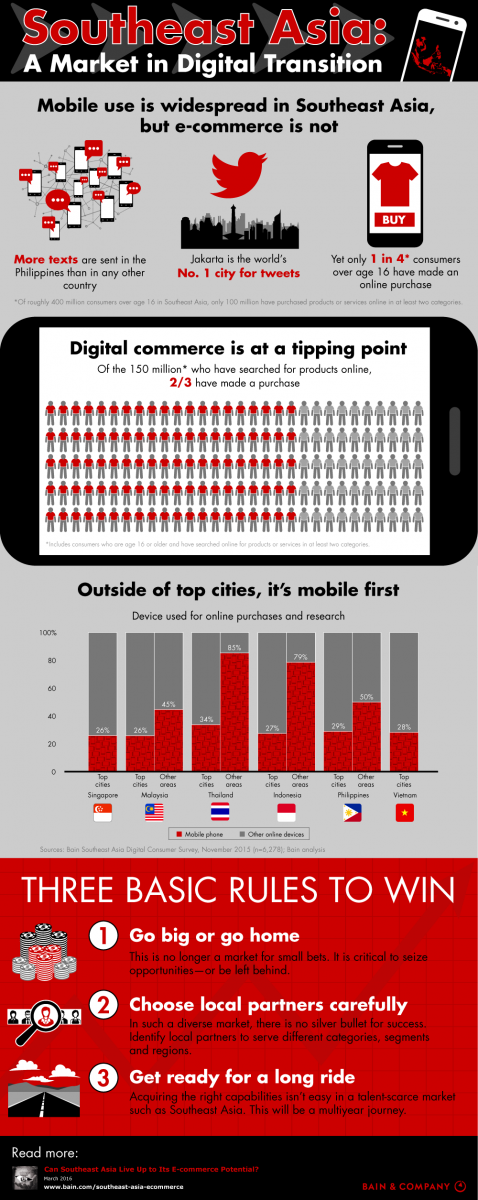How technology can help Southeast Asia’s small businesses to scale
By Alberto Granados February 23, 2017
- SMEs can use cloud technology to circumvent infrastructure issues without large IT investment
- IoT can help SMEs transform business processes, drive efficiency and become more competitive

 TODAY’S business landscape is becoming increasingly fast-paced and digital, but despite technological advancements, many small and medium-sized businesses (SMBs) in Southeast Asia have largely remained low-tech and low-skilled.
TODAY’S business landscape is becoming increasingly fast-paced and digital, but despite technological advancements, many small and medium-sized businesses (SMBs) in Southeast Asia have largely remained low-tech and low-skilled.
In fact, a recent Microsoft’s New World of Work SMB Study has shown that small businesses across the Asia Pacific region in general are lagging in their employees’ expectations to be more productive, collaborative and innovative in a world that is more connected than ever.
With SMBs making up 96% of all enterprises in the Asean region and generating most of the region’s employment opportunities, this shortfall could potentially hinder economic growth of some of the member countries, especially where the definition of SMBs include market stalls, neighbourhood retailers, home-industries, and services in brick-and-mortar set-ups.
Many families in the region also still rely on traditional industries such as farming, agriculture and the production of garments, and lack the means or know-how to optimize crop yields or scale production. As such, helping this majority of businesses to expand, scale and realise their full potential is crucial to the economic health of the region.
While governments in Southeast Asia are keen to develop their ICT (information and communications technology) sector and do recognise the benefits and efficiencies of keeping up with technology trends, inherent infrastructure deficiencies such as a lack of reliable broadband connectivity and bandwidth may hinder SMBs when it comes to setting up their businesses and achieving scale. Limited ICT skills among workers, inertia and simply a lack of time are also some of the other barriers hampering the adoption of new technologies.
However, there are enormous business opportunities and cost-savings that SMBs could enjoy, just by using technology to modernise and scale their businesses, fuelling productivity and growth.
According to a joint Microsoft and Boston Consulting Group study, tech-savvy SMBs create more new jobs and drive more revenue gains than SMBs that use little technology.
Research also showed that technological advancements such as cloud services bring the potential for the most far-reaching innovation and business growth ever, creating a huge opportunity for more SMBs to achieve the growth rates of technology leaders.
Some of these new business opportunities come with changes in technology, such as the rise of internet sensors, machine learning and the Internet of Things (IoT), all disruptive technology which will the future of SMBs, but at the same time, create new revenue streams, offer greater ease of use and flexibility, and drive repeat customers.
Here are three ways that small business owners can use the power of technology to improve competitiveness, innovate and scale their businesses:
Driving innovation with IoT
The Internet of Things is not only for big businesses – it also brings a wealth of opportunities for smaller enterprises to transform their business processes, drive efficiency and become more competitive. Those that take the initiative can gain a competitive advantage.

For example, Peregrine Corporation (pic above), a convenience retailer in South Australia, leverages IoT sensors to automatically log the temperature of their product storage systems, freeing staff for more value-added tasks, reducing the chance of equipment failures, and delivering greater operational transparency.
Sensor-collected data is then aggregated into the Microsoft Azure IoT Suite, letting the Peregrine team assess the system’s health status and where they require resources, resulting in a more efficient allocation of resources and the ability to pre-empt systems failures. From its initial store rollout, the company has benefited from savings on labour costs and reduction of organisational risk.
This can be replicated and scaled with SMBs in the region – while IoT would require an initial investment in equipment and solutions, the efficiencies reaped lead to a slew of long-term advantages and cost savings.
Scaling through cloud technology
While not all SMBs are able or willing to make a large investment in IT, adopting new technologies is still an option. With much of Southeast Asia’s ICT infrastructure lagging growth opportunities, small businesses can use cloud computing technology to circumvent infrastructure issues without large IT investment.

For example, health tech start-up RingMD (pic above) in Singapore taps the power of the cloud to connect patients and doctors around the world, regardless of location and time zone. By deploying services on cloud platforms, every interaction is digitized and stored securely on servers online.
The raw data allows RingMD to build algorithms that help doctors and hospital administrators make decisions based on real insights. Thanks to the scalability and flexibility of the platform, RingMD today manages patient records of 1.5 million people in more than 50 countries globally, while working with 10,000 healthcare providers, and expects to work with 100,000 healthcare providers and 15 million patients by the end of 2016.
Reaching target audiences through automated technology
In our mobile-first and cloud-first world, chatbots are the future – in countries like Singapore, for example, the government is already exploring a shift towards conversational computing for government services.
The Southeast Asian region is also rapidly growing into its social commerce potential, and messaging is beginning to dominate social interactivity. According to a Bain & Company study, more than 80% of digital consumers use social media or messaging apps to research products and connect with sellers, and social sales comprise of up to 30% of all transactions online.
With chatbots, businesses can imitate conversational commerce, reaching out to target audiences in more personable ways. Such intelligent services can augment SMBs’ services, and give them an edge over the competition as consumers seek more intuitive and efficient solutions, despite the growing complexity of technologies today.
For example, Skype bots such as the Skyscanner Bot lets consumers search for flights, returning live prices and route options within Skype.
Chatbots could be a good way for SMBs to scale customer service, especially for enterprises with a small number of employees. Not only will the company be able to engage with more customers without having to hire more customer services reps, current staff will also be freed up for higher value tasks.
Technology can thus help to level the playing field between SMBs and large corporations and small businesses across Southeast Asia should begin to seize these opportunities today.
Alberto Granados is vice president of Microsoft Asia Pacific
Related Stories:
Funding Societies launches FS Bolt app to provide fast and secure loans for SMEs
DBS Bank Indonesia launches SME-focused DBS BusinessClass app in Jakarta
Print security will increase in importance
Cisco boost for Asia’s SMBs and midmarket businesses
For more technology news and the latest updates, follow us on Twitter, LinkedIn or Like us on Facebook.


